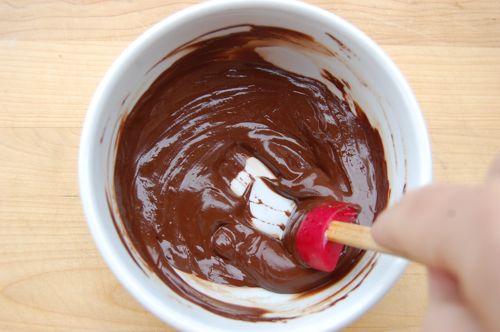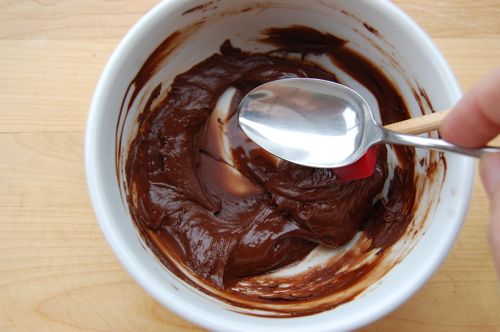How to “Un-Seize” Chocolate
You know how it goes. One minute you’re happily stirring a batch of melted chocolate, dum dee dum dum…

…and all of a sudden it starts to darken and thicken mysteriously. What the…? It seems to shrink in volume and looks oddly greasy.

Then in a few seconds it’s seized up into a thick, putty-like chocolate goo.

What caused this? The answer of course: a small quantity of water somehow got into the bowl. Typically this sort of thing happens when chocolate is being melted over a double boiler, and water vapor or drops of condensation find their way into the pan. It’s just one of the reasons I prefer a microwave. Can anything be done about this?
Yes indeed. More heat? Nope, the chocolate’s already melted, even though at the moment it doesn’t look that way. More heat will only burn it. The answer is more water. Are you kidding, Joe? It’s water that got me into this mess!
That’s true. A small amount of water caused the problem. A larger quantity of water will solve it by creating more syrup and allowing the molten chocolate mixture to flow again. So we just add perhaps a spoonful or so of hot water…

…stir, and a few moments later we’re pretty much back to where we were. Pretty much. The chocolate has some water in it now, so it’s not so good for something like tempering. However it’s perfectly good for ganache, a flourless chocolate cake, or any of a thousand other uses.

Whew! That was a close one…
Hi Joe,
I am glad I read this article on how to save the chocolate that can’t be tempered. However, I was trying to find an economical way of tempering chocolate without having to invest $400 plus on a tempering appliance. It seems that the double boiler and glass chocolate thermometer is what I’ll have to take my chances on unless you might know an easier method.
Speaking of chocolate/candy thermometers, I saw an online video demonstration in that once the pot of water came to a simmer, heat was turned off, bowel with chocolate placed on top, one hand stirred while the other was careful not to let the glass thermometer touch anything but the chocolate to avoid a false read. It looked a little tricky and awkward.
So, I searched for a digital chocolate thermometer with a clip and read mixed reviews on both the quality of the device and/or measuring accuracy. Do you have any recommendations or brands you might suggest?
The information I read about refrigerating the chocolate in molds in your other article was helpful. I am realizing how tricky working with chocolate can be. I would like to eventual learn to make shiny chocolate that snaps!
Today is the day, I am going to color the poured fondant you taught me to make on cookies!
Thanks so much! Ahn
Hi Ahn! Thank you for the kind comments. Other than a tempering machine, or perhaps a sous vide cooker (which is just as expensive), a double boiler and thermometer is really the only choice. Concerning brands, I don’t usually buy anything too expensive. Standard Taylor thermometers (the brand most restaurants favor) work well and are inexpensive as well. I use their glass thermometers, instant-read digital thermometers and their probe thermometers.
Amazing! I thought it was ruined beyond repair. What a great tip to learn. Thank you.
Thank you so much for this explanation! I was making ice cream. Melt chocolate over double boiler. Check. Slowly, whisk (that’s a joke, right) in milk… Grainy, gravely mess! I quickly found this article and realized that if I pre-heated the milk in the microwave (so it was similar temp) and kept adding it, it would smooth out, because milk has water in it. Guess what? It did! I was ready to throw the whole thing in the trash, and here it was just fine all along. Thank you for the explanation!
Woohoo!
Thanks for the note, Lynn! Glad it worked so well for you.
– Joe
Thanks so much for your help with our chocolate emergency! My son was melting chocolate chips to make frosting, and it seized.
We panicked.
Other sites we checked maintained that once chocolate has seized, it’s not salvageable, with no further explanation. So, without help from your site, we’d have thrown it all away, and a great afternoon baking a cake with my two sons would have turned into a depressing disaster.
Your explanation saved our frosting, our cake, and our day.
Thanks so much for all the help!
Great to hear that, Annie! It’s a lot easier than most people think. And while the chocolate isn’t technically the same after you add water to it, it’s still good for all sorts of things!
Cheers and happy baking!
– Joe
This is completely genius and just prevented a fight in my kitchen.
Ha! That’s good to hear, Cindy. There’s enough stress in the Thanksgiving kitchen already! All the best to the Oberlin crowd. I love that school!
Cheers,
– Joe
Thanks! This tip just saved me a bunch of time and trouble and my chocolate mousse ended up turning out wonderful. 🙂
Woohoo!
Great to hear, Kat. Thanks for the note!
– Joe
You’re a miracle worker! I happened upon your website while looking for explanations for buttercream, and I got addicted ever since. I’m making a birthday cake for my mum this weekend and my chocolate fudge filling seized something bad. Good thing I remembered seeing this article from you and saved the whole thing! Thank you! <3 all the way from Manila.
Woohoo!
Thanks, Renee! So glad it worked out for you…and hope the weather’s good in Manila! 😉
Cheers,
– Joe
Great tip, you are a god amongst men
Lorenzo, I thank you!
Best of luck with the project,
– Joe